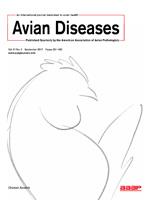Recently we demonstrated that co-infection with Avibacterium paragallinarum and Gallibacterium anatis leads to increased severity of clinical signs of infectious coryza in birds. The present study examined the interaction of these two pathogens in chickens by evaluation of histologic lesions in sinus infraorbitalis and nasal turbinates, applying a defined scoring scheme ranging from 0 to 3. Furthermore, for the first time, an in situ hybridization (ISH) technique was applied to detect A. paragallinarum in tissues. The samples were received from vaccinated and nonvaccinated birds that were infected with A. paragallinarum and/or G. anatis. Vaccinated birds were mostly devoid of any histopathologic lesions except a few birds with lesion score 1 at 7 and 14 days postinfection (dpi). Likewise, nonvaccinated birds infected with G. anatis only did not present microscopic changes in the sinus infraorbitalis, except in a single bird at 7 dpi. Interestingly, median lesion scores caused by G. anatis infection were significantly higher in the nasal turbinates of infected birds than in negative control at 7 and 14 dpi. The most prominent histologic changes were recorded from sinus infraorbitalis and nasal turbinates of nonvaccinated birds that were infected either with A. paragallinarum only or together with G. anatis. ISH demonstrated positive signals for A. paragallinarum in exudates present in the lumen or attached to the epithelial layer of investigated tissues. Such signals were mainly detected in tissues from birds with the highest histopathologic lesion scores.
How to translate text using browser tools
3 July 2017
Presence of Avibacterium paragallinarum and Histopathologic Lesions Corresponds with Clinical Signs in a Co-infection Model with Gallibacterium anatis
Surya Paudel,
Daniel Ruhnau,
Patricia Wernsdorf,
Dieter Liebhart,
Michael Hess,
Claudia Hess
ACCESS THE FULL ARTICLE

Avian Diseases
Vol. 61 • No. 3
September 2017
Vol. 61 • No. 3
September 2017
Avibacterium paragallinarum
chickens
Gallibacterium anatis
histopathology
in situ hybridization
infectious coryza




